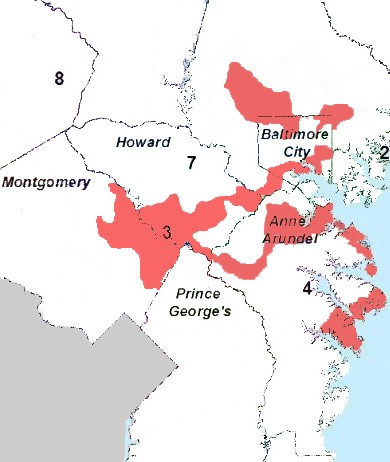
The 3rd district, as proposed by the Governor's Redistricting Advisory Committee. Graphic by MarylandReporter.com.
The first highlight the Governor’s Redistricting Advisory Committee touted about the congressional district plan it officially released Tuesday was that “more than 70% of Marylanders will remain in their current Congressional district.”
That means something like 30% of the people — almost a third of the state — will be moved into new districts. This is reputedly to “reflect population changes over the past decade reflected in the Census.”
But the odd thing is that Maryland’s population in the past decade grew by only 9%. According to data the state Department of Planning prepared as the process began, six of the eight congressional districts were within plus or minus 3% of the ideal size of 721,529. Rep. Steny Hoyer’s 5th Congressional District, due to hot growth in southern Maryland, was 6.5% over (49,000 people), and Elijah Cummings’ 7th was 8% under (57,000 people) due to city population loss.
Overall, according to the Planning Department, a total of 174,000 Marylanders needed to be shifted around to make the current districts come out even.
Instead what the committee proposed shifts almost 10 times that number — 1.7 million people — if the committee’s 30% figure is accurate. In a statement yesterday, Gov. Martin O’Malley said, “It is my intention to introduce a map that is substantially similar to the map submitted by the committee.”
Why so much change when so little was needed? The committee’s narrative doesn’t help very much.
In Harford and Prince George’s counties, the number of districts was reduced from three to two – “a desire expressed by residents,” said the committee, and “consistent with public testimony.” But in Anne Arundel County, where residents pleaded to get back the resident member of Congress that they had for decades or to be placed in at most two districts, the committee split the county into three (rather than the current four).
Throughout the commentary, the committee notes the importance of the U.S. House members representing the interest of federal facilities in their districts. But isn’t that something of a pork barrel formulation? Members of Congress are supposed to represent the interests of their constituents, which may not coincide with the military and government institutions nearby.
3rd District map is missing
The most telling feature of the committee’s explanation is what it fails to say and show about the 3rd Congressional District. That district was one of the most gerrymandered 10 years ago, when a majority of it was shifted to Anne Arundel County, forcing then-Rep. Ben Cardin to campaign where he was not well known before. (That exercise may have helped him in the long run to win his Senate seat.)
The committee has posted eight maps on its Planning Department site. None of them show the 3rd District in full. As best we can on short notice, we’ve put together a map of what that district looks like. Yikes, you might say. What kind of monster is it?
The district drawn by Massachusetts Gov. Elbridge Gerry in 1812 that a cartoonist said looked like a salamander is compact and rational compared to the ink blot that is the committee’s 3rd District.
In the north, it starts in Owings Mills and dips down into Baltimore. Then it creeps almost invisibly along the city line out to Parkville, and slinks back along the city line to East Baltimore, then southwest through Lansdowne into Elkridge, Columbia and Fulton (mostly as it does now). Then it takes a new grand leap across the Patuxent River into Olney and Burtonsville, almost driving down to Silver Spring.
But we must not forget the tentacle that lopes along the Patuxent, heads north into Severn and Glen Burnie, then out to the old black resort of Riveria Beach on the Chesapeake Bay and south to the gated community of Gibson Island. Poor Congressman John Sarbanes will have to take out his kayak and cross the Magothy River into Arnold, then make portage to the Severn River where at last he lands in Annapolis. Whew! Hope he has a GPS device.
The committee’s explanation of this meandering is one brief sentence: “Congressional District 3 remains a Central Maryland district that incorporates portions of the Baltimore and suburban Washington regions.”
Surely someone can do better than that. Whatever the committee’s plans might be in trying to unseat Republican Rep. Roscoe Bartlett, at least his current 6th District is compact and contiguous.


